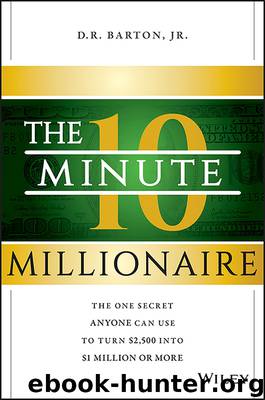The 10-Minute Millionaire by D. R. Barton Jr

Author:D. R. Barton, Jr.
Language: eng
Format: epub
ISBN: 9781118856802
Publisher: Wiley
Published: 2017-01-16T10:00:00+00:00
Figure 4.1 Loss Aversion Bias
Take a moment to think about this. It’s really quite astonishing.
For a computer operating on pure logic, it’s all the same math. The outcomes of any choice are exactly the same regardless of the starting point. In fact, even in the case of a coin flip, my expected return is still the same $15 as my guaranteed payout option (50 percent × $10 + 50 percent × $20 = $15). The computer would say that all choices are equal—especially over multiple trials of the experiment.
Put this into a human brain and logic gives way to emotions and mental framing.
The subjects in Scenario Number 1 start with $10. So the status quo (doing nothing) feels like a gain of $5. By flipping a coin, they risk losing their small gain in exchange for a bigger gain. So they avoid that choice.
This is the exact same rationale traders use when they cut their gains short by selling a stock for a small profit rather than risk dropping back to breakeven even if there’s a good probability for a bigger gain.
Subjects in Scenario Number 2 start with $20. So the status quo (that is, doing nothing) feels like a guaranteed loss of $5. They’d rather risk an even bigger loss for a chance to stay at their perceived breakeven point.
This is exactly what traders do when they let their losses ride. When a position moves against them, instead of getting out at a predetermined stop point, their natural human aversion to actually realizing (locking in) that loss causes them to hang on to the loser, hoping it will turn around. That perfectly describes Tom in my coaching story.
What’s fascinating to me is that when this is put into a mathematical context, the starting position is completely irrelevant to our current decision. Regardless of past events, the options we have in front of us right now are entirely identical. Yet it’s the perception of our past starting point that drives actual human behavior and our resulting choices.
If there’s a better window directly into the human brain, I have yet to find one.
This illogic plays out each and every day in the markets.
I can’t tell you how many times I’ve heard a student trader in a losing position say something like: “Yeah, but it’s just a paper loss . . . and it’ll rebound.”
In other words, as long it’s just a “paper loss” (that is, on their brokerage statement), it’s not yet real. In their mind, there’s still a chance for a rebound (however improbable that rebound actually might be). But once you cash out—actually book the loss—that loss is locked in . . . it’s official.
And investors do all they can to avoid that feeling . . . that finality.
That’s loss aversion bias.
The better question to ask—the query that (sometimes) snaps us out of this bias—is, “If you didn’t own this stock, but saw it on this downtrend today, would you buy it?” The answer—as we see with the participants in Scenario Number 1 of the coin-flip experiment—is almost always “no.
Download
This site does not store any files on its server. We only index and link to content provided by other sites. Please contact the content providers to delete copyright contents if any and email us, we'll remove relevant links or contents immediately.
Rich Dad Poor Dad by Robert T. Kiyosaki(6185)
Pioneering Portfolio Management by David F. Swensen(6083)
How To Win Friends and Influence People by Dale Carnegie(4340)
The Money Culture by Michael Lewis(3851)
The Dhandho Investor by Mohnish Pabrai(3564)
The Wisdom of Finance by Mihir Desai(3529)
Liar's Poker by Michael Lewis(3228)
The Intelligent Investor by Benjamin Graham Jason Zweig(2936)
The ONE Thing by Gary Keller(2922)
Mastering Bitcoin: Programming the Open Blockchain by Andreas M. Antonopoulos(2895)
Fooled by Randomness: The Hidden Role of Chance in Life and in the Markets by Nassim Nicholas Taleb(2866)
Rich Dad Poor Dad: What The Rich Teach Their Kids About Money - That The Poor And Middle Class Do Not! by Robert T. Kiyosaki(2836)
How to Win Friends and Influence People by Dale Carnegie(2799)
Investing For Dummies by Eric Tyson(2798)
How to Day Trade for a Living: Tools, Tactics, Money Management, Discipline and Trading Psychology by Andrew Aziz(2787)
Market Wizards by Jack D. Schwager(2545)
Zero Hour by Harry S. Dent Jr. & Andrew Pancholi(2536)
How to Pay Zero Taxes, 2018 by Jeff A. Schnepper(2503)
Rich Dad's Guide to Investing by Robert T. Kiyosaki(2412)
